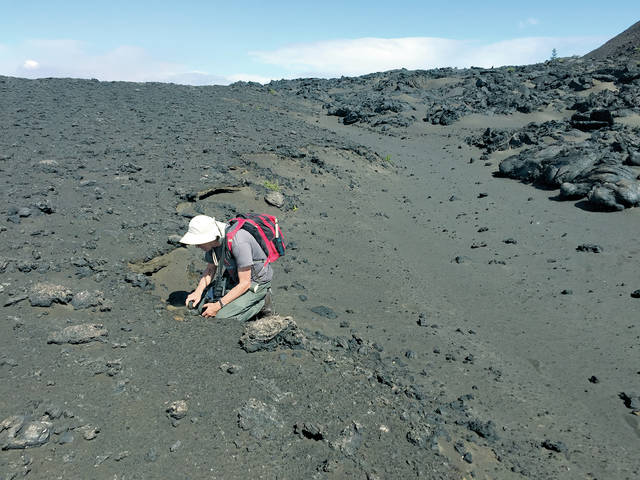Sometimes the days go by and you don’t seem to accomplish much. Emails, phone calls, paperwork, futzing around just aren’t getting you anywhere.
Faced with frustration, it’s good to stand back, take a deep breath and examine what was learned during decades of study of Hawaiian volcanoes. From such perspective, astounding progress was made, and we at the Hawaiian Volcano Observatory are privileged to be part of the story.
Unlike sausage-making, the scientific learning process is open to observation, warts and all. Blunders, some rather embarrassing, will be caught, even if made by luminaries.
For example, Thomas Jaggar, founder of HVO, once thought Kilauea was older than Mauna Loa, a conclusion quite opposite from what we know today.
Generally, though, it is not blunders but small errors that are corrected. Even more often, new data or changes in interpretation drive the process forward.
Progress is incremental, sometimes two steps forward and one step back or, momentarily, even the reverse. Grand breakthroughs are unusual, plate tectonics being an example.
With that said, where do we stand today with big picture knowledge of Kilauea and Mauna Loa acquired during the past few decades?
Hawaiian volcanoes seem to remain active for several hundred thousand, perhaps a million, years. Mauna Loa is well into its life span and, eventually, will be replaced by Lo‘ihi, now a large and growing seamount south of Hawaii Island. Kilauea probably has more years ahead of it than behind, starting perhaps 300,000 years ago.
The two volcanoes formed along different curving but parallel lines, the Loa and Kea trends, that erupt chemically different magma. This was recognized in the 19th century as a geometric pattern but was not identified chemically until the last half of the 20th century.
Giant submarine landslides, first recognized in the early 1960s, have peeled away from the west side of Mauna Loa, most recently about 105,000 years ago. No such giant slides are known at Kilauea
The south or southeast flanks of both volcanoes are continuously moving southeastward a few centimeters a year because of volcano spreading. Gravity is the principal cause, aided by intrusion of magma into rift zones.
The summit of each volcano sits atop a poorly understood pathway that transports magma upward from a melting site 100 km (62 miles) deep in the Earth’s mantle. A shallow reservoir system 2-5 km (1-3 miles) deep caps this pathway, and magma moves from there upward to the surface or into the rift zones that sprout laterally from the reservoir.
Most eruptions produce lava flows, a fact long known, but each volcano has violent explosive eruptions triggered by pent-up magmatic gas or steam from heated groundwater. Explosive eruptions are not unusual during a time horizon of centuries and need consideration in long-term planning.
These findings, far from exhaustive, are awfully impressive. All were acquired since the late 1950s and took major effort to amass the necessary evidence.
They result from research. Whether at a university or a volcano observatory, research is needed to better understand volcanism. The science can’t stand pat, arrogantly assuming it already knows enough to suit society’s needs. To improve, we must always learn more.
Here are some important questions about Mauna Loa and Kilauea that we can’t yet answer:
What are the details of melting in the mantle, and why does the supply rate of magma from the mantle to the shallow plumbing system change through time?
What will cause the next giant landslide from Mauna Loa and, perhaps, the first from Kilauea?
Can we develop a way to determine how long an eruption, once underway, will last?
Can the next explosive eruption be predicted? How large will it be?
A new concept for Kilauea is that periods dominated by explosive activity last centuries and alternate with periods of similar length dominated by lava flows. If so, when will the next explosive period start at Kilauea? What clues might foretell it? When will it end?
Such questions drive research — with progress inevitable, even while at times frustratingly slow.
Volcano activity updates
This past week, Kilauea Volcano’s summit lava lake level generally rose in concert with summit inflation, ranging from about 30-50 m (98–162 ft) below the vent rim. On the East Rift Zone, the 61g lava flow remained active downslope of Pu‘u ‘O‘o, with scattered breakouts on the pali and coastal plain. The ocean entry remained inactive. The 61g flows do not pose an immediate threat to nearby communities.
Mauna Loa is not erupting. Small-magnitude earthquakes continue to occur beneath the summit caldera and upper Southwest Rift Zone at depths less than 5 km (3 mi). A few deeper earthquakes were scattered beneath the volcano’s southeast and west flanks at depths of 5-13 km (3-8 mi). GPS and InSAR measurements continue to show slow deformation related to inflation of a magma reservoir beneath the summit and upper Southwest Rift Zone. Overall, rates of seismicity and deformation have decreased. No significant changes in volcanic gas emissions were measured.
There were three events with three or more felt reports in the Hawaiian Islands during the past week. At 7:09 a.m. Dec. 13, a magnitude-2.8 earthquake occurred 3 km (2 mi) northwest of Honaunau-Napoopoo at 13 km (8 mi) depth. At 6:39 a.m. Dec. 11, a magnitude-2.7 earthquake occurred 9 km (6 mi) south-southeast of Volcano at 8 km (5 mi) depth. And at 2:13 p.m. Dec. 10, a magnitude-2.5 earthquake occurred 3 km (2 mi) east-southeast of Leilani Estates at 2 km (1 mi) depth
Visit the HVO website (http://hvo.wr.usgs.gov) for past Volcano Watch articles, Kilauea daily eruption updates and other volcano status reports, current volcano photos, recent earthquakes, and more; call (808) 967-8862 for a Kilauea summary update; email questions to askHVO@usgs.gov.
Volcano Watch (http://hvo.wr.usgs.gov/volcanowatch/) is a weekly article and activity update written by U.S. Geological Survey`s Hawaiian Volcano Observatory scientists and colleagues.






